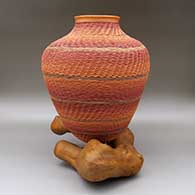
Jamie Zane Smith
Wyandot

Jamie Zane Smith tells us he has a strong personal commitment to building Wyandot pottery. He's working to retain an integral sense of form inspired by sensibilities from a time when people lived in the full awareness that they were not separate from the Earth.
Jamie uses traditional resources to create pottery that speaks to the modern world. For him, his creating of pottery is a participation in the flow of Nature, from a perspective where humans and Nature are not dueling entities but rather a single continuous flowing of prayer in a language of glory to the Creator.
Jamie has learned much through watching his uncle, Richard Zane Smith, creating his own form of Wyandot pottery. Jamie spent a year in Wyandotte, Oklahoma, studying with his uncle. He learned that the making of pottery is a spiritually honest form of sensibility. There's also something about getting his hands into and working with clay that speaks to his heart.
Jamie says he grew up in the city and has traveled the world since finishing his formal education. The time spent with his uncle convinced him that the rural way of life is the life he wants to live with his wife and their two daughters.
These days they live "lightly and simply" in an old two-room schoolhouse in the Ozark Mountains of Missouri. In a small valley at the point where two creeks meet, the schoolhouse hasn't changed much since the days when his wife's grandparents attended school there. Jamie says the peace and the beauty of the ever-changing wooded landscape are a constant inspiration for him.
100 West San Francisco Street, Santa Fe, New Mexico 87501
(505) 986-1234 - www.andreafisherpottery.com - All Rights Reserved

Wyandot

Wyandot mocassins from about 1880
Before the arrival of Columbus, the ancestors of today's Wyandot(te) lived mostly in the countryside stretching north from the north shore of Lake Ontario to the north and east shores of Georgian Bay (on Lake Huron to the north). Members of the tribe were scattered as far south as the Kanawha River in central West Virginia but as Europeans flooded in from the east in the 1600s and 1700s, they were forced out and moved north to rejoin the rest of their tribe.
In their Ontario homelands, there were basically five nations making up the Huron Confederacy. Most of today's survivors we now know as Wyandot but originally the tribe was known as Huron, based on their occupation of lands to the north, east and south of Lake Huron.
Around 1600 the tribe was comprised of two primary groups: the Huron Confederacy (of the 5 nations) and their neighbors to the south and southwest, the Tionontate (also known as the Tobacco people, after their principal commodity crop). Like the Huron, the Tionontate were longhouse dwellers and spoke a very similar dialect. The Anishinabe, to the north and east, were also longhouse dwellers and spoke a similar dialect.
When news of the French arrival in North America reached the Huron, some of them decided to go and meet the newcomers. Samuel de Champlain was exploring the upper reaches of the St. Lawrence River at that time. The two groups came together in 1609 and a political and trade alliance was forged. Within 20 years of that fateful meeting with Champlain, the tribe was reduced from about 30,000 members to maybe 12,000 due to diseases brought by the French that the indigenous people had no immunity to. At the same time, the Dutch and English presence was having similar impacts among the tribes south of the St. Lawrence and the Great Lakes. That effect mushroomed after the British took over the Dutch colonies in the mid-Atlantic area.
The drop in population was catastrophic: whole villages, families and clans disappeared, their agricultural lands abandoned. Jesuit missionaries were everywhere and they further fractured the tribe into "redeemed" people and "unredeemed" heathens. As the fur trade in the New World was strongly pushed, beavers were pushed almost to the brink of extinction and conflict among the tribes increased significantly. As the most advanced trading nation in the French area, the French invested more in their alliance with the Huron while the English allied themselves with the Hurons' mortal enemies: the Seneca and the Haudensaunee (Hutinǫhšǫdih) Iroquois to the west and south.
A difference between the Dutch/English and French invasions: the Dutch and English would trade firearms with anyone for beaver pelts while the French required conversion to Christianity before allowing any trade in firearms. When push came to shove, France's allies were outgunned and outnumbered by Britain's. In the aftermath of the French & Indian War, France's New World allies were made to suffer further.
The Huron enjoyed good trade and amicable relations with their Anishinabe neighbors. Neither tribe wanted any disruption of that. However, the disparity in access to firearms and the growing scarcity of beaver led the Haudensaunee Iroquois to attack two Huron villages in present-day Simcoe County, Ontario, killing about 300 people on March 16, 1649. By May 1, 1649, the Huron had burned 15 of their own villages to prevent their stores from being stolen by their enemies. Many of those villagers fled into surrounding areas where they were taken in by other tribes. About 10,000 Huron fled to Christian Island in Georgian Bay but most of those starved to death during the next winter. Many of the survivors made their way downstream along the St. Lawrence and settled at Wendake, near Quebec City, where their descendants remain to this day (these are today's Wendat people, a recognized First Nation).
As the massive Iroquois and Seneca war party made its way around in Huron territory in 1649, they attacked other Huron and Tobacco people villages. That resulted in the Bear Clan of the Huron merging with the Tionontate as refugees from both flowed across Lake Huron and Lake Michigan to the area of Green Bay. A couple seasons later most of those moved north and settled in the area of Michilimackinac. Others scattered to the west and south, passing into southeastern Michigan and across Ohio into the Ohio River Valley in the early 1700s. At that point the Huron and Tionontate in the west were essentially one tribe: Wandat. At the time, Wandat meant "people of the village" or "people of the island," but as the 1800s rolled on, that definition became "villager" and the word itself morphed to Wyandot. That's when the name Wyandot came into general use.
During the American Revolution, the Wyandot allied themselves with the British against the Americans and in one of the last engagements of the Revolutionary War (the Battle of Blue Licks, fought 10 months after the surrender of Cornwallis at Yorktown), they surrounded and defeated Daniel Boone's Kentucky Militia. During the Northwest Indian War (1785-1795) they fought alongside the British and were signatories to the Treaty of Grenville in 1795. However, in 1807, along with the Potawatomi, Odawa and Ojibwe peoples, they were conned into signing the Treaty of Detroit. Instead of protecting those tribes from continuing encroachment on their lands as promised, that treaty transfered most of their holdings in southern Michigan and northwestern Ohio to the US Government Land Office for a minimal cash payment and annuity. They were allowed to keep small pockets of land in the area but this treaty marked the beginning of the migrations forced by the federal policy of Indian removal.
In the 1840s most of the surviving Wyandot people were displaced to Kansas Territory, where they used what remained of the proceeds of their sale of southeastern Michigan and northern Ohio to purchase about 23,000 acres of land from the Delaware (Lenape) in what is now Wyandotte County, Kansas. That purchase happened because the Lenape were grateful for the hospitality they had received from the Wyandot in Ohio when they (the Lenape) were also forced to move west under pressure from incoming Anglo-American colonists. A couple other small pieces of fertile land were granted to the tribe in the early 1840s, along with 32 "floating sections" of land west of the Mississippi River. In 1850 they sold some of their land back to the federal government for almost $127,000 and invested most of those proceeds in government bonds.
In 1853, William Walker was elected the provisional governor of Nebraska Territory (which included Kansas) during an election at the Wyandot Council House in Kansas City. As a leader of the Wyandot people he was also elected by white traders and other outside interests in an effort to preempt federal organization of the territory. Congress refused to recognize Walker's election but the political activity did force Congress to pass the Kansas-Nebraska Act and separate the two into separate territories. That was also necessary in the run-up to the Civil War in order to balance free and pro-slavery votes in Congress. It didn't work out well. That was also a time when the tribe itself divided along pro-slavery and abolitionist lines. There were also major problems with extreme poverty among the tribe's members and with sleazy Anglo-European traders and land-grabbers stealing the land out from under the people. That's how the tribe got broken further into the scattered groups we see today.
By 1855 the official population of the tribe was less than 700 individuals. That year they sold the rest of the 32 "floating sections" (located in Kansas, Nebraska and "unspecified" locations) for $25,600. Surveys were not required and titles became complete at the time of site location. In the 1940s the federal government began to address a long-standing Wyandot land claim based on their having been forced to sell their Ohio lands for less than fair market value in order to comply with the Indian Removal Act. In 1985 the Bureau of Indian Affairs finally settled the claims by paying $1600 to each of the approximately 3,600 people in Kansas and Oklahoma who could prove they were descendants of Wyandot originally affected by the Indian Removal Act.
In the United States there is one federally recognized tribe: the Wyandotte Nation, headquartered in Wyandotte, Oklahoma. In Canada there is one Wyandot First Nation: the Huron-Wendat Nation headquartered in Quebec City, Quebec. The Wyandot Nation of Anderton, headquartered in Trenton, Michigan, and the Wyandot Nation of Kansas, headquartered in Kansas City, Kansas, are both unrecognized tribes, even though both are composed of Wyandot descendants.
100 West San Francisco Street, Santa Fe, New Mexico 87501
(505) 986-1234 - www.andreafisherpottery.com - All Rights Reserved


Jamie Zane Smith, Wyandot, Largepolychromejarwithaslightlyflaredopening,acoileddesign,andadriftwoodstand
Wyandot
$ 3500
zzmm3h728
Large polychrome jar with a slightly flared opening, a coiled design, and a driftwood stand
13.25 in L by 13.25 in W by 16 in H Measurement does not include stand, stand adds approximately 4 inches to height
Condition: Very good, some rubbing and minor wear on stand, jar has minor slip cracks
100 West San Francisco Street, Santa Fe, New Mexico 87501
(505) 986-1234 - www.andreafisherpottery.com - All Rights Reserved



